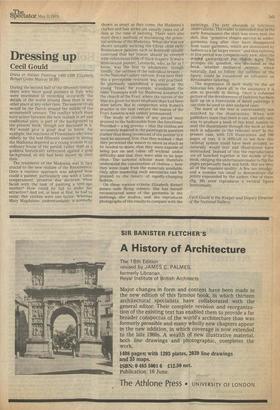Dressing up
Cecil Gould
Dress in Italian Painting 1460-1500 Elizabeth Birbari (John Murray £6.00) During the second half of the fifteenth century there were more good painters in Italy who were interested in recording accurately the details of the world around them than in any other place at any other time. The nearest rivals would be the Dutch around the middle of the seventeenth century. The conflict which must have arisen between the new realism in art and traditional piety is part of the background to the present book, though not discussed in it. We would give a good deal to know, for example, the reactions of Florentines who were elderly by the mid-fifteenth century to seeing the Madonna depicted as a young woman in an ordinary house of the period, rather than as a goddess hieratically enthroned against a gold background, as she had been shown up until then.
The treatment of the Madonna was in fact crucial to the new realism of the Renaissance. Once a realistic approach was adopted how could a painter, particularly one with a Latin temperament, preserve due decorum when faced with the task of painting a teen-age mother? How could he fail to make her attractive? And yet, at least at first, he had to resist. Her clothes were one factor. Whereas Mary Magdalene, understandably, is normally
shown as smart as they come, the Madonna's clothes and hair styles are usually years out of ,date at the time of painting. There were also more direct methods of minimising the potential sexiness of the Madonna. When she was not shown actually suckling the Christ child early Renaissance painters such as Botticelli usually contrived that her bosom should be covered with voluminous folds of thick drapery. It waS a homosexual painter, Leonardo, who, as far as I know, was the first to adumbrate, though timidly, the outlines of the individual breasts — in the National Gallery cartoon. Even later than this a perceptible restraint was still practised. So gloriously uninhibited a painter as the young Titian, for ,example, scandalised the older Venetians with his Madonna Assumed in the church of the Fran, where the curves of the hips are given far more emphasis than had been done before. But in comparison with Ruben's practice in the next century the bosom of the Fran i Assunta is not unduly pronounced.
The study of clothes of any period must proceed to the fashionable from the functional. Provided — a big proviso — that the clothes are accurately depicted in the paintings in question (rather than being inventions of the painter's) it must be assumed, first. that they worked — that they permitted the wearer to move as much as he needed to move, that they were capable of being put on and taken off without undue difficulty and that they were able to be kept clean. The sartorial scholar must therefore understand the construction of clothes — how they were made from the materials available. Only after mastering such necessities can he proceed to the luxury of rapidly-changing fashion.
On these various criteria Elizabeth Birbari passes with flying colours. She has herself reconstructed some of the garments in the paintings she studies, and she reproduces photographs of the results to compare with the
paintings. The text abounds in felicitous observations. The reader is reminded that in the early Renaissance the shirt was worn next the skin, that -primitive shapes survive as undergarments long after they have disappeared from outer garments, which are dominated by fashion to a far larger extent" and that tailoring in this period was comparatively new, after the draped garments of the Middle Ages. This prompts the question, not discussed in the book, whether mediaeval armour, which naturally had to follow the outlines of the figure, could be considered an influence on Renaissance tailoring.
The importance of such study to the art ' historian lies, above all, in the assistance it is able to provide in dating. Once a coherent picture of the development of fashions has been built up on a foundation of dated paintings it can then be used to date undated ones.
The merit of the text is unfortunately not matched by the illustrations. When will publishers learn that there is one, and only one, way to produce a book of this kind, namely to seed the illustrations through the book so that each is adjacent to the relevant text? In the present case, with 115 illustrations and 106 pages of text, it is difficult to see how this rational system could have been avoided, so naturally would text and illustrations have interlocked. Instead of this the reproductions are all bunched together in the middle of the book, obliging the unfortunate reader to flip the pages perpetually back and forth. Nor are they all of the requisite quality. A few are smudgy, and a number too small to demonstrate the points expounded by the author. One of them (fig. 39) even reproduces a vertical figure horizontally.
Cecil Gould is the Keeper and Deputy Director of the National Gallery.


































 Previous page
Previous page